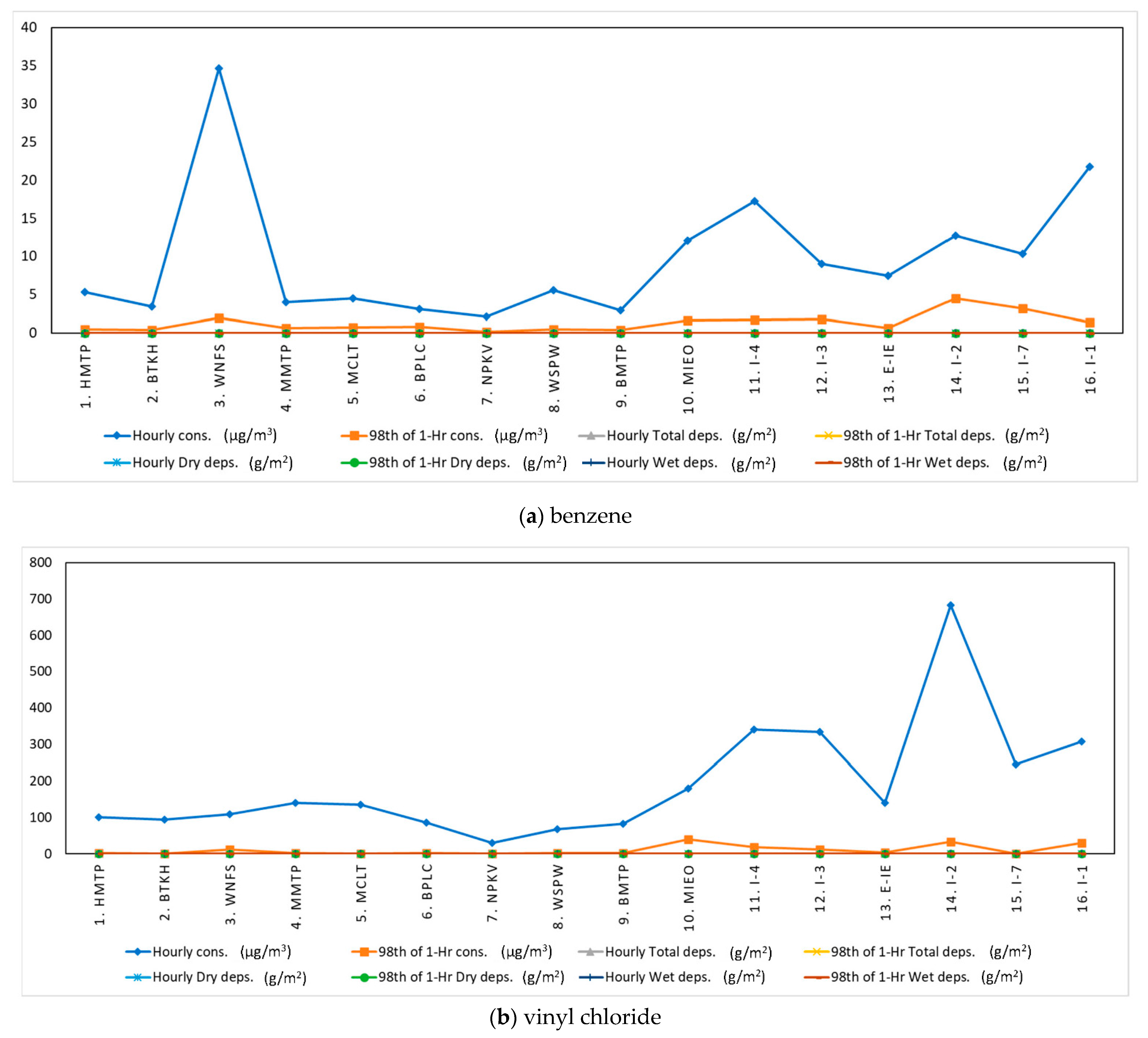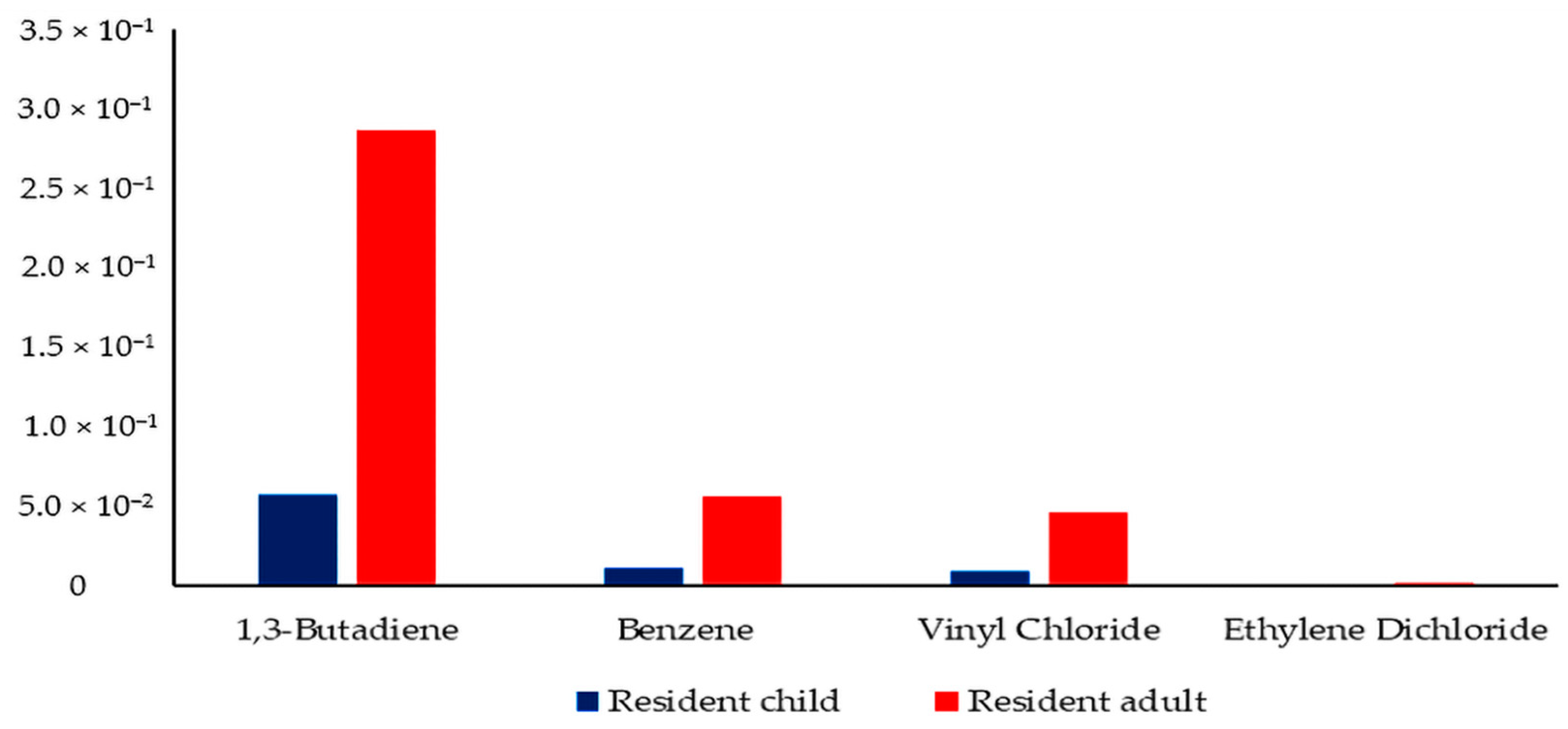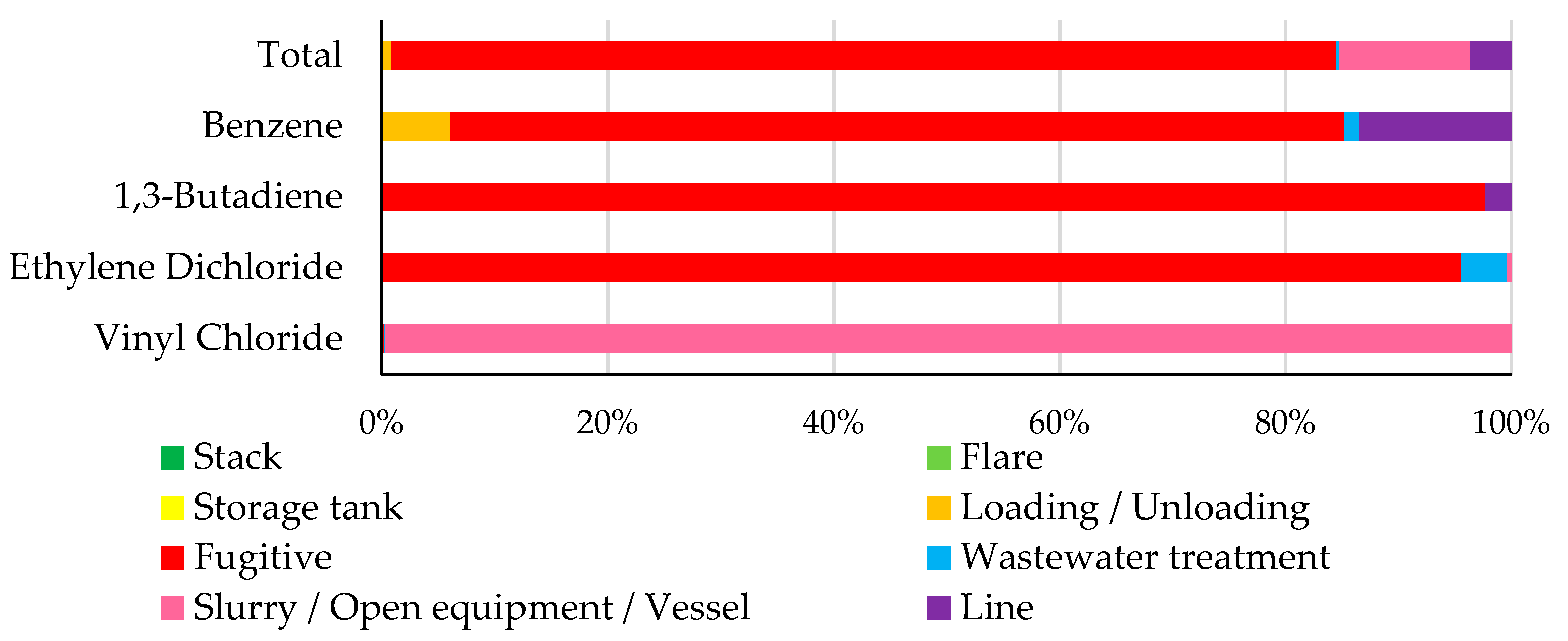Modeling of Inhalation Health Risk of Volatile Organic Compounds in the Vicinity of Maptaphut Petroleum and Petrochemical Industrial Estate, Thailand
Abstract
1. Introduction
2. Methods
2.1. Targeted VOC Emission Characteristics
2.2. HHRAP
2.3. Source Emission Inventory
2.4. Air Dispersion and Deposition Modeling
2.4.1. Model Configuration
2.4.2. Risk Mode Output
2.5. Risk Modeling
2.5.1. COPC Database
2.5.2. Exposure Scenarios
2.6. Risk Characterization of Inhalation
2.6.1. Quantitative Estimation of Chronic Cancer Risk
2.6.2. Cancer Numeric Target Levels
3. Results and Discussion
3.1. Emission Inventory Results
3.2. Air Modeling Results
3.3. Health Risk Modeling Results
Assessment of the Carcinogenic Risk
4. Uncertainties and Limitations
5. Conclusions
Supplementary Materials
Author Contributions
Funding
Institutional Review Board Statement
Informed Consent Statement
Data Availability Statement
Acknowledgments
Conflicts of Interest
Abbreviations
| µg/m3 | Microgram per cubic meter |
| AERMOD | American Meteorological Society/Environmental Protection Agency |
| Regulatory Model | |
| AIEC | Acute Inhalation Exposure Criteria |
| COPC | Chemical of Potential Concern |
| EI | Emission Inventory |
| Fv | Fraction of Volatilization |
| HHRAP | Health Risk Assessment Protocol |
| IARC | International Agency for Research on Cancer |
| IRIS | Integrated Risk Information System |
| IRAP-h | Industrial Risk Assessment Program-Human Health |
| PBT | Persistence, Bioaccumulation, Toxicity |
| URF | Inhalation Unit Risk Factor |
| VOC | Volatile Organic Compound |
| SOV | Slurry, Open Equipment, Vessel |
References
- United States Environmental Protection Agency. PBT Profiler. Office of Pollution Prevention and Toxics. 2006. Available online: http://www.pbtprofiler.net/ (accessed on 12 January 2021).
- Vallero, D.A. Chapter 35-Waste management accountability: Risk, reliability, and resilience. In Waste; Academic Press: Cambridge, MA, USA, 2019; pp. 693–740. [Google Scholar] [CrossRef]
- National Research Council. Environmental transport and exposure pathways of substances emitted from incineration facilities. In Waste Incineration & Public Health; National Academies Press: Washington, DC, USA, 2000. Available online: https://www.ncbi.nlm.nih.gov/books/NBK233615/ (accessed on 15 February 2021).
- Sijm, D.T.; Rikken, M.; Rorije, E.; Traas, T.; Mclachlan, M.; Peijnenburg, W. Transport, accumulation and transformation processes. In Risk Assessment of Chemicals; Springer: Dordrecht, The Netherlands, 2007; pp. 73–158. [Google Scholar] [CrossRef]
- Pratt, G.C.; Dymond, M. Multipathway screening factors for assessing risks from ingestion exposures to air pollutants. J. Air Waste Manag. Assoc. 2009, 59, 419–429. [Google Scholar] [CrossRef] [PubMed]
- Chusai, C.; Manomaiphiboon, K.; Saiyasitpanich, P.; Thepanondh, S. NO2 and SO2 dispersion modeling and relative roles of emission sources over Map Ta Phut industrial area, Thailand. J. Air Waste Manag. Assoc. 2012, 62, 932–945. [Google Scholar] [CrossRef] [PubMed]
- Boonpeng, C.; Polyiam, W.; Sriviboon, C.; Sangiamdee, D.; Watthana, S.; Nimis, P.L.; Boonpragob, K. Airborne trace elements near a petrochemical industrial complex in Thailand assessed by the lichen Parmotrema tinctorum (Despr. ex Nyl.) Hale. Environ. Sci. Pollut. Res. 2017, 24, 12393–12404. [Google Scholar] [CrossRef] [PubMed]
- Office of Natural Resources and Environmental Policy and Planning. Emission Sources Data in Map ta Phut Area for Air Modeling; ONEP: Bangkok, Thailand, 2016. Available online: https://www.onep.go.th/ (accessed on 5 January 2021).
- Soytong, P.; Perera, R. Spatial analysis of the environmental conflict between state, society and industry at the Map Ta Phut-Rayong conurbation in Thailand. Environ. Dev. Sustain. 2017, 19, 839. [Google Scholar] [CrossRef]
- Asa, P.; Jinsart, W. Effects of Air Pollution Related Respiratory Symptoms in Schoolchildren in Industrial Areas Rayong, Thailand. Environmentasia 2016, 9, 116–123. [Google Scholar] [CrossRef]
- Soytong, P.; Perera, R. Use of GIS tools for environmental conflict resolution at Map Ta Phut Industrial Zone in Thailand. Sustainability 2014, 6, 2435–2458. [Google Scholar] [CrossRef]
- Mirrezaei, M.A.; Orkomi, A.A. Gas flares contribution in total health risk assessment of BTEX in Asalouyeh, Iran. Process. Saf. Environ. Prot. 2020, 137, 223–237. [Google Scholar] [CrossRef]
- Mihajlović, V.; Grba, N.; Suđi, J.; Eichert, D.; Krajinović, S.; Gavrilov, M.B.; Marković, S.B. Assessment of Occupational Exposure to BTEX in a Petrochemical Plant via Urinary Biomarkers. Sustainability 2021, 13, 7178. [Google Scholar] [CrossRef]
- Tsai, J.H.; Gu, W.T.; Chung, I.I.; Chiang, H.L. Airborne air toxics characteristics and inhalation health risk assessment of a metropolitan industrial complex. Aerosol Air Qual. Res. 2019, 19, 247–2489. [Google Scholar] [CrossRef]
- Chen, M.J.; Lin, C.H.; Lai, C.H.; Cheng, L.H.; Yang, Y.H.; Huang, L.J.; Yeh, S.H.; Hsu, H.T. Excess lifetime cancer risk assessment of volatile organic compounds emitted from a petrochemical industrial complex. Aerosol Air Qual. Res. 2016, 16, 1954–1966. [Google Scholar] [CrossRef]
- Jung, J.H.; Choi, B.W.; Kim, M.H.; Baek, S.O.; Lee, G.W.; Shon, B.H. The characteristics of the appearance and health risks of volatile organic compounds in industrial (Pohang, Ulsan) and non-industrial (Gyeongju) areas. Environ. Toxicol. Chem. 2012, 27, e2012012. [Google Scholar] [CrossRef] [PubMed][Green Version]
- Hsu, C.Y.; Chiang, H.C.; Shie, R.H.; Ku, C.H.; Lin, T.Y.; Chen, M.J.; Chen, N.T.; Chen, Y.C. Ambient VOCs in residential areas near a large-scale petrochemical complex: Spatiotemporal variation, source apportionment and health risk. Environ. Pollut. 2018, 240, 95–104. [Google Scholar] [CrossRef] [PubMed]
- Snyder, R. Leukemia and benzene. Int. J. Environ. Res. Public Health 2012, 9, 2875–2893. [Google Scholar] [CrossRef] [PubMed]
- Kirkeleit, J.; Riise, T.; Bråtveit, M.; Moen, B.E. Increased risk of acute myelogenous leukemia and multiple myeloma in a historical cohort of upstream petroleum workers exposed to crude oil. Cancer Causes Control 2008, 19, 13–23. [Google Scholar] [CrossRef]
- International Agency for Research on Cancer. Chemical Agents and Related Occupations. IARC Monographs on the Evaluation of Carcinogenic Risks to Humans; IARC: Lyon, France, 2012; Volume 100, pp. 225–248. Available online: https://www.ncbi.nlm.nih.gov/books/NBK304416/ (accessed on 5 March 2021).
- Sathiakumar, N.; Delzell, E.; Hovinga, M.; Macaluso, M.; Julian, J.A.; Larson, R.; Cole, P.; Muir, D. Mortality from cancer and other causes of death among synthetic rubber workers. Occup Environ. Med. 1998, 55, 230–235. [Google Scholar] [CrossRef]
- Ministry of Public Health. Health Data Center (HDC). 2019. Available online: https://hdcservice.moph.go.th/hdc/main/index.php (accessed on 7 September 2021).
- United States Environmental Protection Agency. Human Health Risk Assessment Protocol (HHRAP) for Hazardous Waste Combustion Facilities (Final), EPA530-R-05-006; OSWER: Washington, DC, USA, 2005. Available online: https://archive.epa.gov/epawaste/hazard/tsd/td/web/html/risk.html#hhrad (accessed on 22 December 2020).
- United States Environmental Protection Agency. 2011 NATA: Assessment Results. 2011. Available online: https://www.epa.gov/national-air-toxics-assessment/2011-nata-assessment-results (accessed on 18 December 2021).
- Minnesota Pollution Control Agency. Minnesota Air Toxics Emission Inventory. 2008. Available online: http://www.pca.state.mn.us/air/toxics/toxicsinventory.html (accessed on 14 April 2021).
- Munshed, M. Mobile Toxics Human Health Risk Assessment Framework. Master’s Thesis, University of Waterloo, Waterloo, ON, Canada, 2018. [Google Scholar]
- Thepanondh, S. Establishment of VOCs Emission Inventory in Thailand: A Report on Methods and Early Results. In Seminars on Development of Environment and Emission Standard VOC; PCD: Bangkok, Thailand, 2006. Available online: http://infofile.pcd.go.th/air/VOC_sarawut1.pdf (accessed on 19 November 2020).
- Gordian, M.E.; Frazier, R.; Hill, A.; Schreiner, I.; Siver, D.; Stewart, A.; Morris, S. Health Effects of Indoor-Air Benzene in Anchorage Residences: A Study of Indoor-Air Quality in Houses with Attached Garages. In Institute of Social and Economic Research; UAA: Anchorage, AK, USA, 2009; Available online: http://hdl.handle.net/11122/4330 (accessed on 10 March 2021).
- Hughes, K.; Meek, M.E.; Walker, M.; Beauchamp, R. 1,3-Butadiene: Human health aspects. In Concise International Chemical Assessment Document 30; WHO: Geneva, Switzerland, 2001; Available online: https://apps.who.int/iris/handle/10665/42367 (accessed on 15 June 2021).
- Minnesota Pollution Control Agency. Air Emissions Risk Analysis (AERA). 2007. Available online: http://www.pca.state.mn.us/air/aera.html (accessed on 16 April 2021).
- Thepanondh, S. Development of Emission Factors for Air Pollutants and Greenhouse Gases from Vehicle for Establishment of Appropriate Mitigation Policy and Measure in the Transportation Sector in Thailand; Mahidol University: Bangkok, Thailand, 2012. [Google Scholar]
- Gulia, S.; Shrivastava, A.; Nema, A.K.; Khare, M. Assessment of Urban Air Quality around a Heritage Site Using AERMOD: A Case Study of Amritsar City, India. Environ. Model. Assess. 2015, 20, 599–608. [Google Scholar] [CrossRef]
- EU Regulations. Directive 2006/11/EC of the European Parliament and of 15 February 2006 on pollution caused by certain dangerous substances discharged into the aquatic environment of the Community. Off. J. Eur. Union 2006, 64, 52–59. [Google Scholar]
- United States Environmental Protection Agency. Region 6 Risk Management Addendum—Draft Human Health Risk Assessment Protocol for Hazardous Waste Combustion Facilities, EPA-R6-98-002. 1998. Available online: http://www.epa.gov/region06 (accessed on 18 March 2021).
- Jin, J.X.; Sun, S.D.; Wang, P.; Lin, Y.C.; Wang, T.; Wu, L.; Wei, N.; Chang, J.Y.; Mao, H.J. Vehicle emission inventory and scenario analysis in Liaoning from 2000 to 2030. Huan Jing Ke Xue 2020, 41, 665–673. [Google Scholar] [CrossRef]
- Garcia-Herrero, I.; Margallo, M.; Laso, J.; Onandía, R.; Irabien, A.; Aldaco, R. Measuring the Vulnerability of an Energy Intensive Sector to the EU ETS under a Life Cycle Approach: The Case of the Chlor-Alkali Industry. Sustainability 2017, 9, 837. [Google Scholar] [CrossRef]
- Randall, P.M. Pollution prevention strategies for the minimizing of industrial wastes in the VCM-PVC industry. Environ. Prog. 1994, 13, 269–277. [Google Scholar] [CrossRef]
- Xia, W.; Liang, B.; Chen, L.; Zhu, Y.; Gao, M.; Chen, J.; Wang, F.; Chen, Y.; Tian. Atmospheric wet and dry depositions of polycyclic aromatic compounds in a megacity of Southwest China. Environ. Res. 2022, 204, 112151. [Google Scholar] [CrossRef] [PubMed]
- Barber, J.L.; Thomas, G.O.; Kerstiens, G.; Jones, K.C. Current issues and uncertainties in the measurement and modelling of air–vegetation exchange and within-plant processing of POPs. Environ. Pollut. 2004, 128, 99–138. [Google Scholar] [CrossRef] [PubMed]
- Pinthong, N.; Thepanondh, S.; Kondo, A. Source Identification of VOCs and their Environmental Health Risk in a Petrochemical Industrial Area. Aerosol Air Qual. Res. 2022, 22, 210064. [Google Scholar] [CrossRef]




| Carcinogenicity and Toxicity | Possibility of Exposure | Standard and Surveillance Values |
|---|---|---|
|
|
|
| Target VOCs | Carcinogenicity and Toxicity Values | Carcinogen Classification | Std. of Annual Mean Cons.; µg/m3 | 24-h Surveillance Cons.; µg/m3 | |||||
|---|---|---|---|---|---|---|---|---|---|
| RfC; mg/m3 | URF; 1/(μg/m3) | AIEC; mg/m3 | IARC 1 | EPA 2 | ACGIH 3 | JSOH 4 | |||
| Benzene | 0.03 | 7.80 × 10−6 | 1.3 | 1 | A | A1 | 1 | 1.7 | 7.6 |
| 1,3-Butadiene | 0.002 | 5.88 × 10−5 | 0.66 | 2A | A | A2 | 1 | 0.33 | 5.3 |
| 1,2-Dichloroethane | 2.4 | 2.60 × 10−5 | 202 | 2B | B | A3 | 2A | 0.4 | 48 |
| Vinyl Chloride | 0.1 | 8.80 × 10−6 | 180 | 1 | A | A1 | 1 | 10 | 20 |
| Level I | Level II | EI (Tons/Year) | |||
|---|---|---|---|---|---|
| BZ | BD | EDC | VCM | ||
| Industrial sources | Stack | 0.53 | 0.74 | 0.06 | 0.06 |
| Flare | 0.18 | 0.02 | 0 | 0 | |
| Storage tank | 0.06 | 0 | 7.11 | 0 | |
| Loading and unloading | 1.85 | 0.05 | 0.00 | 0 | |
| Fugitive | 1.40 | 0.58 | 0.36 | 0.44 | |
| Wastewater treatment | 1.09 | 1.79 | 0.19 | 0.32 | |
| Slurry, Open equipment, Vessel (SOV) | 0 | 0 | 0 | 36.96 | |
| Total | 5.11 | 3.19 | 7.72 | 37.78 | |
| Non-Industrial sources | Motorcycle | 5.84 | 4.56 | 0 | 0 |
| Passenger car | 61.60 | 3.61 | 0 | 0 | |
| Van and Pick up | 1.02 | 0.44 | 0 | 0 | |
| Truck | 2.87 | 0.96 | 0 | 0 | |
| Bus | 2.46 | 0.40 | 0 | 0 | |
| Total | 73.78 | 9.96 | 0 | 0 | |
| Total | 12 | 78.89 | 13.15 | 7.72 | 37.78 |
Publisher’s Note: MDPI stays neutral with regard to jurisdictional claims in published maps and institutional affiliations. |
© 2022 by the authors. Licensee MDPI, Basel, Switzerland. This article is an open access article distributed under the terms and conditions of the Creative Commons Attribution (CC BY) license (https://creativecommons.org/licenses/by/4.0/).
Share and Cite
Malakan, W.; Thepanondh, S.; Kondo, A. Modeling of Inhalation Health Risk of Volatile Organic Compounds in the Vicinity of Maptaphut Petroleum and Petrochemical Industrial Estate, Thailand. Sustainability 2022, 14, 12073. https://doi.org/10.3390/su141912073
Malakan W, Thepanondh S, Kondo A. Modeling of Inhalation Health Risk of Volatile Organic Compounds in the Vicinity of Maptaphut Petroleum and Petrochemical Industrial Estate, Thailand. Sustainability. 2022; 14(19):12073. https://doi.org/10.3390/su141912073
Chicago/Turabian StyleMalakan, Wissawa, Sarawut Thepanondh, and Akira Kondo. 2022. "Modeling of Inhalation Health Risk of Volatile Organic Compounds in the Vicinity of Maptaphut Petroleum and Petrochemical Industrial Estate, Thailand" Sustainability 14, no. 19: 12073. https://doi.org/10.3390/su141912073
APA StyleMalakan, W., Thepanondh, S., & Kondo, A. (2022). Modeling of Inhalation Health Risk of Volatile Organic Compounds in the Vicinity of Maptaphut Petroleum and Petrochemical Industrial Estate, Thailand. Sustainability, 14(19), 12073. https://doi.org/10.3390/su141912073










